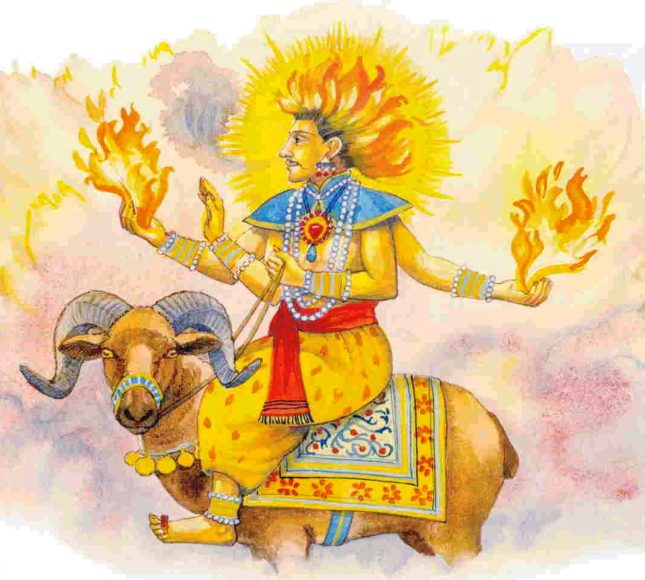\’Wonderful is the fire which works wonders.\’ (Var Asa M. l, p. 464) \’Agni is called Baisantar Devta\’ (Var Asa M. l, p. 473). Its other names are Pavak and Tejas. It is an evolute from Air (Paun Devata) and labours hard like him under the Fear of the Lord. \’When the sun blazes in the sky, the earth is roasted and her sÃ¥p is dried by the fire of the sun.\’ (Baramaba Tuhhart M. l, p. 1108) The sun is the main source of heat (Agni) and light. The fire is latent in wood.
Guru Ram Das says: “The fire is locked in the wood; it is struck only by the person, who knows the method.”(Katyan M. 4, p. 1323) Just as the fire of the womb is within the body, the fire of maya is out (of the body). (Ramkali M. 3, Anand, p. 921) The desire is also a kind of fire, which can be extinguished by the Name of the Lord. There is also a mention of the fire of the forest (Dawa Agan), which destroys the plants and trees of the forest as well as the insects, birds and animals. (pp. 120, 732, 1416) A little spark of fire is enough to bum down a huge stack of flrewood.
(Sorath M. l, p. 637) The fire is also a great purifier. It purifles the metal. (Shalok Farid, p. 1380) The fire of hell is meant for the sinners. The abode of the sinner is in the fire. (Bhairo Namdev, p. 1165) From water, heat (Agni) and electricity are produced. (Maru M. l, p. 1033) There is no direct reference to any episode about Agni, the god of fire in Guru Granth Sahib. We produce below a quotation regarding Agni, the god of fire, as given in Epics, Myths and Legends of India (p. 28) by P. Thomas. It conveys the significance of this Vedic God : “Agni is the lord, protector, king of men.
He is the lord of the house, dwelling in every abode. He is guest in every home; he despises no man, he lives in every family. He is therefore considered as a mediator between gods and men, and as a witness of their actions; hence to the present day he is worshipped, and his Messing sought on all solemn occasions, as at marriage, death, etc. In these old hymns, Agni is spoken of as dwelling in the two pieces of wood, which being rubbed together produce fire, and it is noticed as a remarkable thing that a living being should spring out of dry (dead) wood. Strange to say, says the poet, the child as soon as he is bom begins with unnatural voracity to consume his parents. Wonderful is his growth seeing that he is bom of a mother who cannot -nourish him; but he is nourished by the oblations of clarified butler which are poured into his mouth and which he consumes.”
References :
1. Kohli, Surindar Singh, Dictionary of Mythological References in Guru Granth Sahib, 1993
In Hindu traditions, Agni is revered as the divine mediator between humanity and the gods. Representing both physical fire and the transformative power of inner purification, Agni is central to rituals and spiritual practices. This symbol of fire as a purifier, sustainer, and destroyer resonates deeply across cultures and traditions. The Guru Granth Sahib integrates the essence of Agni to emphasize spiritual purification and enlightenment.
In the hymns of the Guru Granth Sahib, fire often symbolizes the intensity of divine love, the warmth of devotion, and the destruction of ego and impurities. By referencing Agni, the scripture calls upon individuals to ignite the fire of devotion and meditative remembrance (Naam Simran), which can burn away the illusions of ego, attachment, and material desires. The focus shifts from external rituals involving fire to the inner transformative power of divine connection.
The Guru Granth Sahib’s use of the metaphorical significance of Agni also underscores the universality of its teachings. It draws upon this ancient concept to inspire spiritual seekers to live righteously and selflessly, allowing their inner fire to illuminate the path to liberation (mukti). By connecting this reference to Sikh philosophy, the text encourages individuals to channel their energies toward divine remembrance and service to humanity.
In conclusion, the reference to Agni in the Guru Granth Sahib goes beyond its Vedic origins to convey profound spiritual truths. It serves as a reminder of the importance of inner transformation and the burning away of impurities through devotion and humility. This symbolic use of fire encourages individuals to strive for spiritual enlightenment and unity with the divine.







